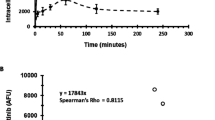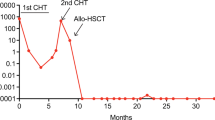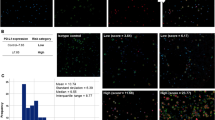Abstract
P-glycoprotein (Pgp), the major mediator of multidrug resistance (MDR) has often been implicated as a poor prognostic indicator in acute myeloid leukaemia (AML). We have previously reported that high expression of the receptor tyrosine kinase c-Kit in AML is associated with poor prognosis. To determine whether the MDR phenotype is associated with high c-Kit expression, the monoclonal antibodies UIC-2 and YB5.B8, which identify Pgp and c-Kit, respectively, were used for indirect immunofluorescence labelling of 50 de novo AML specimens. Quantitative dye efflux studies using Rhodamine123 were also carried out to assess the functional drug efflux capability of these samples. Pgp expression by the majority of primary AML was comparable to that seen in subsets of cells from normal bone marrow and Spearman rank analysis showed no relationship with c-Kit expression (rs = 0.20, P = 0.16). However, c-Kit expression did show a significant correlation with Rhodamine123 efflux (rs = 0.57, P = 0.0001), suggesting that the MDR phenotype, Pgp mediated or other, may contribute to the prognostic significance of high c-Kit expression. The monoclonal antibody UIC-2 was used specifically to block Pgp activity of a limited number of leukaemic specimens and cell lines, and evidence of non-Pgp-mediated efflux was found. The existence of alternative mechanisms may explain the relatively low correlation of Pgp expression with dye efflux within the leukaemic samples (rs = 0.47, P = 0.0006) and has implications for prognosis in AML. The c-Kit ligand, stem cell factor, did not influence drug efflux activity of the nine c-Kit-positive AML specimens tested. Thus the correlation between c-Kit and the MDR phenotype in AML is likely to be a consequence of co-expression at a similar stage of differentiation, and may account for the previously observed association of high c-Kit expression with poor outcome.
This is a preview of subscription content, access via your institution
Access options
Subscribe to this journal
Receive 12 print issues and online access
$259.00 per year
only $21.58 per issue
Buy this article
- Purchase on Springer Link
- Instant access to full article PDF
Prices may be subject to local taxes which are calculated during checkout
Similar content being viewed by others
Author information
Authors and Affiliations
Rights and permissions
About this article
Cite this article
Sincock, P., Ashman, L. Expression of c-Kit and functional drug efflux are correlated in de novo acute myeloid leukaemia. Leukemia 11, 1850–1857 (1997). https://doi.org/10.1038/sj.leu.2400823
Received:
Accepted:
Issue Date:
DOI: https://doi.org/10.1038/sj.leu.2400823
Keywords
This article is cited by
-
Targeting the c-kit receptor in the treatment of acute myelogenous leukemia
Current Hematologic Malignancy Reports (2006)



